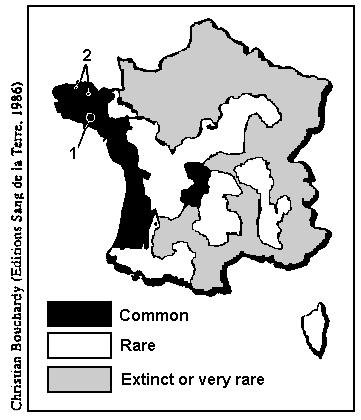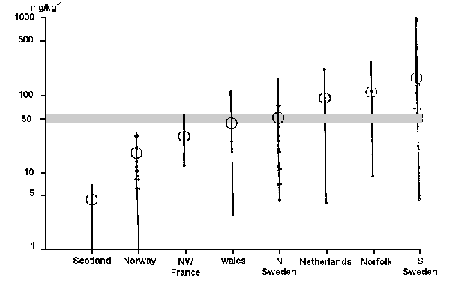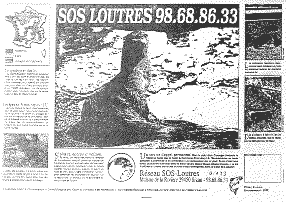 |
Last Update:
Friday November 23, 2018
|
| [Home] |
|
Volume 5 Pages 1 - 83 (March 1990) Citation: Lafontaine, L., Joncour, G. & Menanteau, P. (1990) Otters and bio-accumulating pollutants: first data for western France. IUCN Otter Spec. Group Bull. 5: 51 - 60 Otters and bio-accumulating pollutants: first data for western France Lionel Lafontaine1, Guy Joncour2 and Patrick Menanteau3 1LutrAtlantica,
B.P. 1, 29670 Locquenolé, France, Phone: +33 871 527 061, EMail :lionel.lafontaine@orange.fr, http://www.reseau-loutres.org
Otters, being at the top of the food chain and feeding largely on fish. are likely to be especially vulnerable to the effects of bio-accumulating pollutants. In Europe levels of these compounds (organochlorines, heavy metals) have been reported from samples of Otters in Scandinavia (Olssen & Sandegren, 1983), the British Isles (Chanin & Jefferies, 1978; Mason et al, 1986) and the Netherlands (Broekhuizen & De Ruiter-Dijkman, 1988). Such analyses on aquatic predators have never been done in France with the exception of Alzieu & Duguy (1979) on marine mammals (range 84.6 - 319.5 mg kg-1 fat of PCBs from four grey seals). Recently three otters (Lutra lutra) were killed by traffic on the same road in Brittany (NW France 52°91N; 5°58W). We therefore grasped this opportunity to measure the contamination of those specimens. We had two objectives: to widen our pathological and toxicological knowledge, of which little is known in France, of a rare wild species which is now the subject of an active campaign of protection and awareness; to learn of habitat pollution by pooling several faunal specimens, to accumulate the first evidence of contamination from one of the basins where otters are still common in France (Figure 1).
CURRENT STUDY Between March 1987 and February 1988, three otters were found dead at a roadside near the Gulf of Morbihan in southern Brittany, following collisions with cars. Concurrently, with the approach of the national "Network SOS-Otters" lobbying local authorities to build otterways in this particularly murderous area for the species, we have undertaken this analysis. To widen the study, we have analysed freshwater fish and water. Finally, we analysed bodies of three American mink from the northern Breton coast, thus extending the geographic span of this contribution. ECOTOXICOLOGICAL ANALYSIS Within the organism, fatty tissues are a preferential target for the fat-soluble organochlorines. The main fat. usually used, comes from the kidneys but is limited within the otter to a thin strip. This is why we had to take out the conjunctive fat of the pericaudal area. The lipid-rich encephalon was also removed. After consulting foreign studies, we also removed muscle samples from the deep gluteal area, as well as the liver and the kidneys. The levels of organochlorines and heavy metals in otter and mink tissues are shown in Table 1. For each specimen, they tally to the first three tissues where the highest concentration has been observed. Similarly, of ten organochlorines prospected, shown here are only three compounds which display the highest levels : PCB (-DP6 or Aroclor 1260). dieldrin and lindane. The seven others were absent or present as traces. One must specify that DDT, DDD and DDE can be hidden on the chromatogram by PCBs and this could explain an apparent absence. These results show that PCB concentrations are nowhere negligible, and even significant in the muscle of the third otter (56ppm) and in the livers of the first and third mink (52ppm and 48ppm). We know that at this threshold breeding can be affected. We are, nevertheless, far from the levels observed in England, the Netherlands or Sweden. Dieldrin and lindane concentrations were low though the first otter had a Dieldrin level of 3ppm in liver. Mercury concentrations were on the whole negligible in otters but significant in mink. The lead concentrations are low but constant for the whole of the sample. Cadmium concentrations were negligible. DISCUSSION This series of analyses, never published in France for aquatic predators such as otters or mink, amounts to only a preliminary study taking into account the small size of this sample;. However, it allows us to examine some tendencies regarding the contamination from toxic residues in some areas of French wetlands. The fish diet of the otter is well known and these prey are responsible for most of its contamination. Keck (Veterinary National School of I.yon) shows PCB levels in roach in most rivers and French waterways today at several ppm. A French departmental order of February 1988 gives 2ppm PCBs in fresh weight as the upper limit for fish healthiness in freshwater for human consumption. This level must next be reduced to the tolerance threshold of 0.5 ppm set by the Central Laboratory of Food Hygiene of Paris. Some surveys carried out in 1988 by the local Sanitary Commission in the pool frequented by these otters, and which supplies the town of Vannes with drinking water, came out with negative results: this water would seem to be drinkable. PCBs are determined at 1.5 ng l-1 in the water, the other organochlorines vary from several thousandths to several hundredths of one ppm. But our analysis of some fish from this pool clearly illustrate the bio-accumulation process: thus, for example, compared with the level of Dieldrin in the water, we find a mean concentration 20,000 times stronger in eels and 150,000 times stronger with the 1st otter analysed. CONCLUSION This preliminary study has allowed us to demonstrate contamination of wetlands by several pollutants: the presence of PCBs, mercury and in a tiniest measure Dieldrin and lead, is worrying, or at least preoccupying, for two water basins in western France. It confirms also that investigations must not be limited to insignificant measures as concerns water, sediments, moss or cyprinids, but must focus equally and especially on aquatic predators: salmonids, pike and carnivorous mammals. Also the particular importance of these basins for human populations and economic activities dependent on water quality (oyster faming, for example) would merit an alertness on the part of local authorities. The levels of pollutants found in this small sample of otters cannot exclude a possible effect on the reproductive potential of the species from western France. The chronological decline of French otters has clearly occurred from east to west and it will be useful to know, as Or. Olsson has suggested for the whole of Europe, if PCBs could explain also this decline in France. The current setting of a national otter programme supported by the French government will allow investigations on 15 other otter specimens. It will therefore be possible to observe possible differences in levels of pollutants found in otters from several French regions, especially from non-residential areas and industrial ones. The map of PCB contamination found in human blood (Figure 3) suggests already such significant differences from SE to NW France
ACKNOWLEDGEMENTS - We are extremely grateful
to Drs D. Jefferies (Nature Conservancy Council, UK), M. Olssen (museum of
Natural History, Sweden) and C. Mason (University of Essex, UK) for their
valuable comments. This work was carried out with the financial support of
a local fellowship (A.P.P.I.I. F-22160 Callac) and the Morbihan Departmental
Hunting Federation. Alzieu, C. & Duguy, R. (1979) Teneurs et
composes organochlores chez les Cetaces et les Pinnipedes frequentant les cotes
de France. Oceanologica Acta 2 (1): 107 - 120 |
| [Copyright © 2006 - 2050 IUCN/SSC OSG] | [Home] | [Contact Us] |




